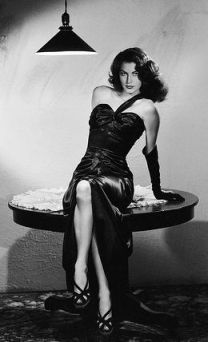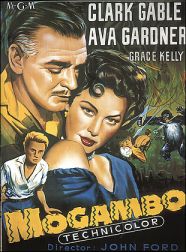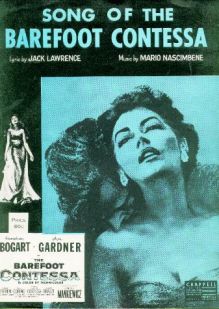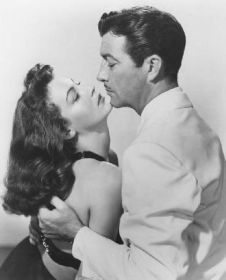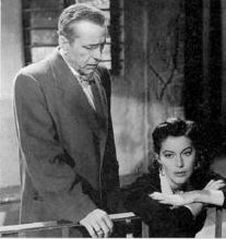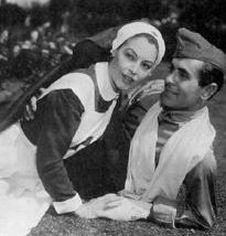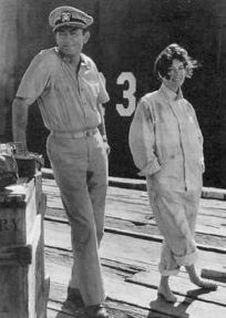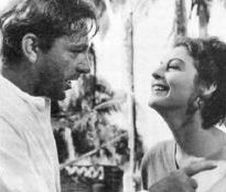
Ava Gardner in a publicity photo for 'The Killers', a 1946 film that also debuted Burt Lancaster. Click for canvas art print.
Beatrice’s husband, Larry Tarr, who was a professional photographer, took some portrait photos of Gardner and displayed them in his Fifth Avenue studio window. One interested party — a Loews Theater messenger trying to get a date with the girl in the photograph — suggested someone send the photos to the MGM film studios, advice which Larry Tarr heeded. He promptly sent a big package of Ava’s photos over to MGM.
Young Ava by this time had returned to North Carolina, where she was attending secretarial classes at Atlantic Christian College. But MGM soon called her to New York for an interview.
In New York, she did a screen test which showed her as awkward and unpolished. Yet when veteran test director Al Altman viewed the footage, he was struck when Gardner looked straight into the camera lens, seeing “a flash of hypnotic fire” there, according to Gardner biographer Lee Server. So Ava was offered a standard studio contract.
Ava Gardner arrived in Hollywood in August 1941 with her sister Beatrice. There, the country girl began to get a make over. An MGM voice coach went to work on her North Carolina drawl, considered nearly incomprehensible, and she was also put through other training. Within a year, she started appearing in films, but would labor in MGM’s backwaters for some years before she would rise to major stardom.
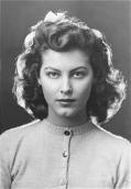
Ava Gardner, age 13.
Ava Gardner was born in a small North Carolina farming community in Johnston County named Brogden, also known by the nickname “Grabtown.” Her father, Jonas Bailey Gardner, was of mixed descent — Irish Catholic and Tuscarora American Indian. At the time of Ava’s birth in 1922, he owned a cotton and tobacco farm, which he worked with his wife and Ava’s mother, Molly, a Baptist of Scots-Irish and English origin. Ava grew up with two brothers and four sisters. Hard times came with the Great Depression, causing the family to lose their farm. Her father then went to work in a saw mill and her mother as a cook and a housekeeper.

Ava Gardner photos taken by Larry Tarr, 1940.
Ava’s first brush with acting came in first grade in the operetta, A Rose Dream — presented at the Brogden School in 1929. During her teens, the family bounced around a bit between Virginia and North Carolina. Her father died in 1935 when Ava was a teenager. She had grown up as a bit of Tom boy running around in bare feet, sneaking cigarettes behind the barn. Hard times also brought her hand-me-down clothes and teasing at school.
At the age of 13, Ava Gardner already had “heart-stopping” good looks. Her mother, however, monitored her suitors, and once followed Ava when she drove with a boy to a nearby lake, dragging her daughter from the car and giving her a stern lecture. A similar fate befell Ava and her boy in the midst of a goodnight porch kiss after a New Years’ dance one year. Her mother was fiercely protective
As a teen, Ava did some Hollywood dreaming, confiding in a note to one girlfriend at age 13: “I always wanted…to be a movie star,” she wrote. “I still do, but I know I can’t so I have about given up hope.” Her favorite actor was Clark Gable. In later years, she also thought about being a singer in a swing band.
Ava and some of her siblings attended high school in North Carolina, with Ava graduating and going on to Atlantic Christian College in Wilson, North Carolina. But it was her trip to her sister’s place in New York, and Larry Tarr’s photographs, that helped change her life and send her to Hollywood.
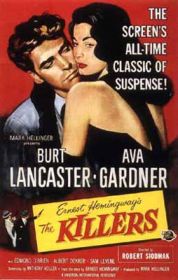
Movie poster from the 1946 film, ‘The Killers,’ staring Ava Gardner and Burt Lancaster. Click for DVD.
Rise To Stardom
In Hollywood, after they smoothed out Gardner’s rough country edges, she appeared in more than 20 films through the early 1940s. But none of these propelled her to stardom. Then in 1946 she played opposite Burt Lancaster in The Killers. It was this film that brought her wide notice. She then became known as a movie star and sex symbol. Other films quickly followed, among them, The Hucksters (1947), One Touch of Venus (1948), The Bribe (1949) with Robert Taylor, and The Great Sinner (1949). By the end of 1950, MGM’s publicity department was sending out black-and-white photos of Gardner at the rate of three thousand requests per week.
In September 1951, Gardner appeared on the cover of Time magazine, featured in a story titled “The Farmer’s Daughter,” which also covered the history and importance of the female star in Hollywood. In the piece, Time’s writers lavished praise on Gardner: “…[T]he consensus is that Ava Gardner may well turn out to be the best thing for Hollywood since the late Jean Harlow.”
Still, Gardner, then 29, was competing with other rising actresses of that day, including: Elizabeth Taylor, 19; Shelley Winters, 28; Jennifer Jones, 31; Susan Hayward, 32; Linda Darnell, 29; Virginia Mayo, 28; and swim star Esther Williams, 29. Betty Grable, 34, was then the reigning box office queen. Other established stars at the time included Irene Dunne, 43; Joan Crawford, 43; and Loretta Young, 38.
Time, in its piece on Gardner, added some caveats, noting that she was not “the most beautiful babe” in Hollywood, nor was she the best actress. However, she exuded an allure and mysterious qualities, said Time, that sent the glamor meters clicking. Time’s writers concluded she just might be the one new star who could bring glamour back to Hollywood.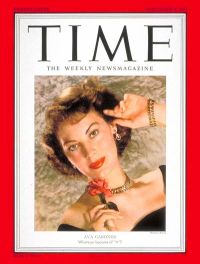
Ava Gardner on Time magazine’s cover, September 3, 1951.
By 1951, Gardner was getting more serious film work and better quality films, with Showboat in 1951 and The Snows of Kilimanjaro in1952. She played opposite Clark Gable in 1953’s Mogambo, a role for which was nominated for an Academy Award, but lost to Audrey Hepburn who had starred in Roman Holiday. In 1954, opposite Humphrey Bogart, she played the title role in The Barefoot Contessa — considered her “signature film” by some — as a Madrid slum gypsy who rises to screen stardom but is murdered by her jealous husband. In 1956 she made Bhowani Junction, with director George Cukor playing an Anglo-Indian half breed heroine who is torn between two cultures and multiple lovers. In 1957’s The Sun Also Rises, she played party-girl Brett Ashley, a 1920s story of post-war ‘lost generation’ expatriates set in Paris and Madrid.
In 1958, Gardner left MGM and became an independent actress, then earning up to $400,000 a movie, most of which were made in Europe. Among her films in this period were: On the Beach in 1959 with Gregory Peck, a story of Australian survivors facing global contamination after a nuclear war; 55 Days at Peking in 1963, a story of Americans in China during the Boxer Rebellion with Charlton Heston and David Niven; and Seven Days in May in 1964 in which she played a patriotic but discarded mistress of a deranged general played by Burt Lancaster.In 1964, Ava Gardner also gave what some thought her finest performance as hotel keeper Maxine Faulk in The Night of the Iguana, a Tennessee Williams story in which she lusts after defrocked priest Richard Burton. In 1968, after undergoing a hysterectomy to allay fears of uterine cancer that had killed her mother, she made the Mayerling, playing the Austrian Empress Elisabeth opposite James Mason playing Emperor Franz Joseph.
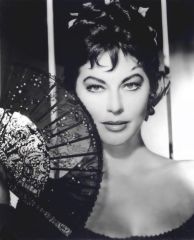
Ava Gardner, 1950s.
Salty Language
Throughout her life, Gardner was known for her frank talk and down-to-earth quips, sometimes cutting to the quick. Of Clark Gable — once her teen idol — she is reported to have said: “Clark is the sort of guy that if you say, ‘Hiya, Clark, how are you?’ he’s stuck for an answer.”
When she arrived in Australia to make the film On the Beach, a remark attributed to her in the press enraged many in that nation. “I’m here to make a film about the end of the world, and this sure is the place for it,” she was reported to have said, although some have charged this was partly invented by the Australian press. Others would also cite her salty language, noting she could “swear like a truck driver.” But it was Gardener’s life off-screen that held a special fascination for many of her fans and the general public.
Arriving in Hollywood as a 19 year-old, Ava Gardner first met and married fellow MGM actor Mickey Rooney. They were wed in January 1942, but divorced 17 months later. She then dated wealthy aviator Howard Hughes for a time thereafter, knocking him out cold once with a heavy candlestick in one stormy confrontation. Despite this, the two remained friends for years.
Gardner’s second marriage came in 1945 to jazz musician and band leader Artie Shaw. It was Shaw’s sixth marriage, and he was highly critical of Gardner’s lack of education. He insisted she read books of his choosing, go to a psychoanalyst, and was often insulting of Gardner in public. The marriage ended after a year and led Gardner into some serious drinking. She would later say of Shaw: “He was god-almighty, I never stood a chance.”
Her third and final marriage was to Frank Sinatra from 1951 to 1957. Sinatra left his wife Nancy and their three kids for Gardner and the whole affair made headlines. The subsequent stormy relationship between Sinatra and Gardner kept the Hollywood gossip columns busy for years (see sidebar section below). They separated in 1953, had a number of reconciliations, but finally divorced in 1957.

Ava Gardner with bullfighter Luis Miguel Dominguin in 1954.
Other men she met throughout her life, such as author and poet Robert Graves, were bewitched by her charm and intelligence. In 1958, Graves wrote short story tribute to her for The New Yorker titled, “A Toast to Ava Gardner.” Bert Pfeiffer, a painter who became captivated by Ava’s performance as a statue who comes to life in the 1948 film One Touch of Venus, began painting regular portraits of her, which he later donated to the Ava Gardner Museum in Smithfield, North Carolina. He also donated his fifty-year collection of other Gardner memorabilia, including European press clippings, slides, negatives, photographs, movie posters, and autographed images.
|
Ava & Frank 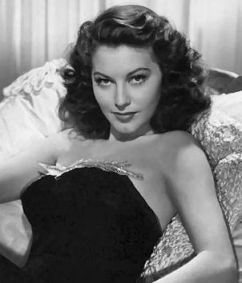 Ava Gardner, circa 1940s. Sinatra on the other hand, had seen better times by then, as his singing and recording career were then in a slump. But the meeting between the two — characterized by some as “The Voice” meets “The Shape” — became a wild night for the pair, who both liked their alcohol. Gardner asked if Sinatra was still married. He said the marriage was over, done with. They continued their talk for hours, drinking and flirting, but soon left the party, taking a bottle along as they departed. They climbed into Sinatra’s Cadillac and roared off down the highways passing the bottle back and forth as they went. Server described them “like two kids on a joyride.” 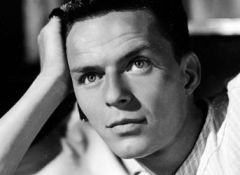 Frank Sinatra, circa 1940s. 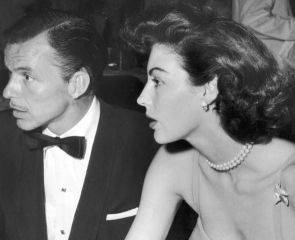 Frank Sinatra with thin mustache and Ava Gardner at the Flamingo in Las Vegas, January 1, 1952. Photo, Hulton Archive / Getty Images. Ava and Frank were married in November 1951, as Sinatra left his wife, Nancy and the kids to be with Ava. Gossip columnists Hedda Hopper and Louella Parsons, along with the Hollywood establishment and all manner of fans, beat up on Sinatra for leaving his “good wife” for Gardner, the exotic femme fatale. Sinatra’s public image had changed by this time, as he was once portrayed as a shy, romantic dreamer leading a quiet family life. The new gossip about Sinatra sold newspapers and magazines by the ton. And Gardner, a top box office draw, had a following too. Adding to the press fervor was the Catholic Church, which denounced both Sinatra and Gardner. Sinatra and his former wife were Catholics. Some church leaders advised their parishioners to boycott Sinatra’s records and Gardner’s films. 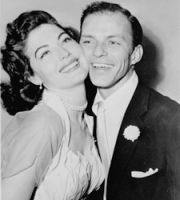 Ava Gardner & Frank Sinatra in happier times. The marriage to Sinatra was stormy — passionate fighting, jealousy, at least one suicide attempt by Sinatra, and numerous separations and reunions. But Gardner reportedly used her influence to get Sinatra cast in the 1953 film From Here to Eternity. Sinatra agreed to play a supporting role in the film for $8,000. But he made the most of it. In fact, in that year, both he and Ava were nominated for Oscars — Ava for Mogambo and he for Eternity. Frank won, but Ava lost to Audrey Hepburn for Roman Holiday.  Frank Sinatra and Ava Gardner at Los Angeles political rally for presidential candidate Adlai Stevenson, 1955. At one point during their marriage, Gardner had become pregnant but had an abortion due to the volatility of their relationship. She had always wanted children, but said in later years: “We couldn’t even take care of ourselves. How were we going to take care of a baby?” Gardner and Sinatra remained good friends for the rest of her life. |
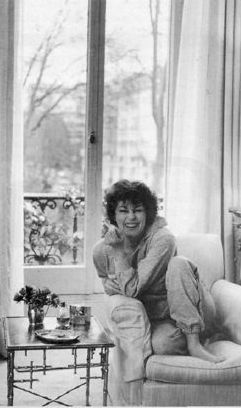
Ava Gardner, London flat, 1984.
Spain & London
After her marriage to Sinatra ended, Gardner moved to Spain, where she had been on previous occasions, and had filmed the 1951 movie Pandora and the Flying Dutchman there. In Spain, Gardner became a big fan of the country’s culture, especially bullfighting and flamenco dancing, and also became involved with bullfighters. One report in Time magazine of September 1955 noted: “In the bull ring of the ancient town of Alcala de Henares, slight, curly-haired Cesar Giron, 21, was so inspired by Ava’s presence in the stands that he dispatched his bull in high style, won both ears and the tail, presented his bloody trophies to Ava, who clutched an ear to her lips for a long kiss as the crowd cheered.”
In 1961 she began year-long affair with Claude Terrail, a European playboy and owner of the Paris restaurant La Tour d’Argent. By the time it ended, Terrail reportedly said: “I had to give up-she was too dangerous for me,” alluding to her Jekyll-and-Hyde type personality after the liquor began to flow. By the late 1960s, Gardner had moved to London from Spain after Spanish tax authorities claimed she owed $1 million in back taxes. In the 1970s she continued to appear in films — as Lillie Langtry in 1972’s The Life and Times of Judge Roy Bean, opposite Paul Newman, and in 1974 opposite Charlton Heston in Earthquake. Retiring from Hollywood film by 1982, she made a television debut in 1985 in the Knot’s Landing series. She also had a notable role as the scheming Agrippina in the 1985 TV miniseries A.D. (Anno Domini), a six-part British/Italian production of the life histories of the Apostles in Rome after the death of Jesus.
Later Life
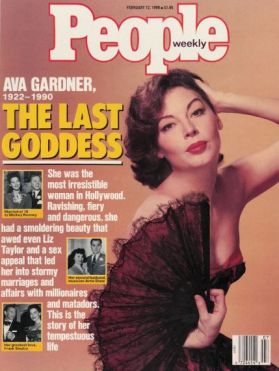
People magazine’s February 1990 cover-story tribute to Ava Gardner, with cover note that read in part: ‘She was the most irresistible woman in Hollywood. Ravishing, fiery and dangerous, she had a smoldering beauty that awed even Liz Taylor...’ Click for copy.
People magazine, in an extensive cover story tribute to Gardner at her death in its February 12, 1990 issue, offered the following on her life and times:
“A siren who was wildly insecure about her looks, a star who swore she couldn’t act, Gardner had always been a study in contradictions. To the moviegoers entranced by Ava during World War II, she was sensuality itself. But while part of her was the flamboyant temptress whose beauty cowed even Elizabeth Taylor, another part was a country girl who went barefoot, took seconds on fried chicken and disliked anything that hinted of pretension. A loner who felt miscast as a movie queen, she learned to drink her liquor straight-not because she liked the taste, but because alcohol took the edge off her shyness. Addicted to stormy relationships, she was a quick-tempered scene maker who fought and made love with equal fervor. In her later years, she began saying that she would have traded her film career for ‘one good man I could love and marry and cook for,’ but friends doubted that she could have made it as a hausfrau…”.
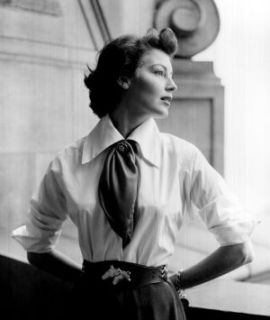
Ava Gardner, sometime in the early-to-mid 1950s.
At her funeral, on a rainy day that reminded some of a scene from The Barefoot Contessa, about 50 relatives and friends gathered at the family plot, where Gardner would be buried next to her brothers and parents. Several hundred others gathered beyond the roped-off grave site. Earlier, some 3,000-odd visitors had come through the Smithfield funeral home to pay their respects, where one flower-wreath’s card was signed, “with my love, Francis.” One rumor had it — and perhaps that’s all it was — that a lone black limousine appeared at the funeral whose occupant never emerged, but was assumed to have been Frank Sinatra. Sinatra died in 1998. Today in Smithfield there is an Ava Gardner Museum in town and also a website. In the summer of 1998, a bronze sculpture of Ava Gardner’s Pandora character was erected in her honor in the village of Tossa de Mar, Spain, where she had made the 1951 film, Pandora and the Flying Dutchman.

Ava Gardner, close up, 1950s.
Ava Gardner appeared in more than 60 films between 1942 and 1982. In June 1999, the American Film Institute included her on a list of greatest Hollywood stars. In 2008, The Killers was selected for preservation in the United States National Film Registry by the Library of Congress as being “culturally, historically, or aesthetically significant.”
At her death, Charles Champlin wrote in the Los Angeles Times:
“Her tall beauty was indubitably regal, but, from the start, the impression was that she was impatient and uncomfortable atop a pedestal, as if she had a fear of that particular height…. If Gardner was a symbol of the swift and dizzying glories that stardom can grant, she was a symbol as well as of its penalties, frustrations and disorientings. Everything is not quite enough, and the line between screen fictions and life as lived can start to blur…”
See also at this website, “Film & Hollywood” or “Celebrity & Icons” for additional stories in those categories. And the topics page, “Noteworthy Ladies,” includes additional story choices on other notable women. For more on Sinatra, see the “Sinatra Stories” topics page. Thanks for visiting – and if you like what you find here, please make a donation to help support the research, writing and continued publication of this website. Thank you. – Jack Doyle
|
Please Support Thank You |
__________________________
Date Posted: 23 May 2009
Last Update: 9 August 2019
Comments to: jdoyle@pophistorydig.com
Article Citation:
Jack Doyle, “Ava Gardner, 1940s-1950s,”
PopHistoryDig.com, May 23, 2009.
_______________________________
Sources, Links & Additional Information
Edwin Schallert, “‘Black Angel’ to Star Ava Gardner at The U,” Los Angeles Times, April 1, 1946. p. 9.
“Artie Shaw’s Ava Gardner Asks Divorce,” Los Angeles Times, August 16, 1946, p.A-1.
Hedda Hopper, “Culture, Not Love, Her Aim Now, Says Ava Gardner; Personal Life Secondary to Film Career,” Los Angeles Times, August 24, 1947, p. C-1.
“Grouchy Sinatra Meets Ava Gardner in Spain; Gossip Says She’s in Love With Bullfighter, Reporters Tell Him Before Rendezvous,” Los Angeles Times, May 12, 1950, p. 14.
“Hearth & Home,” Time, Monday, May 22, 1950.
“Frank Sinatra, Ava Gardner Fly to Mexico,”Los Angeles Times, August 2, 1951, p. 2.
“Hearts & Flowers,” Time, Monday, August 13, 1951.
“The Farmer’s Daughter,” Time, Monday, September 3, 1951.
Hedda Hopper, “Highly Dramatic Role Goes to Ava Gardner,”Los Angeles Times, October 2, 1952, p. B-8.
“People,” Time, Monday, September 19, 1955.
Thomas M. Pryor, “M-G-M Proposes, Actress Disposes; Studio, Seeking Star Roles for Ava Gardner, Runs Into Vehicle Trouble,” New York Times, Friday, January 27, 1956, p. 18.
Ava Gardner, Ava: My Story, New York: Bantam, 1990.
“Ava Gardner,” Wikipedia.org.
Roland Flamini, Ava: A Biography, 1983.
Peter B. Flint, “Ava Gardner Is Dead at 67; Often Played Femme Fatale,” New York Times, January 26, 1990.
Charles Champlin, “Ava Gardner – Image of a Bygone Era,” Los Angeles Times, January 26, 1990, p. F-1.
Burt A. Folkart, “Ava Gardner, Sultry Film Star, Dies at 67 in London,” Los Angeles Times, January 26, 1990.
Michelle Green, Doris Bacon, Eleanor Hoover, Cathy Nolan, Jane Walker, Linda Kramer, David Hutchings, Dick Lemon, “Many Passions, No Regrets — A Hard-Living Renegade Who Hated Stardom, Ava Gardner Became the World-Class Symbol of Scandal and Sexuality,” Cover Story, People, February 12, 1990, pp. 72-81.
Reid Buckley, “Ave Ava — Ava Gardner,” National Review, April 16, 1990.
Robyn Karney, “Ava Gardner,” St. James Encyclopedia of Pop Culture, Gale Group, 2002.
Lee Server, Ava Gardner, Love is Nothing, New York: St. Martin’s Press, 2006, Illustrated, 551 pp.
Ava Gardner Museum in Smithfield, North Carolina.
Janet Maslin, Books of the Times, “Ava Gardner in Lee Server’s Biography: Hollywood Star as Wild Spirit,” New York Times, April 17, 2006.
Peter Bogdanovich, “Ava’s Allure,” Review of Ava Gardner, by Lee Server, Sunday Book Review, New York Times, April 23, 2006.
“Biography of Ava Gardner,” Turner Classic Movies, Movie Data Base.
Jane Ellen Wayne, Ava’s Men: The Private Life of Ava Gardner, 1989, St. Martin’s Press, 260 pp.
Karin J. Fowler,” Ava Gardner: A Bio-Bibliography,” 1990.
Doris Rollins Cannon, Grabtown Girl: Ava Gardner’s North Carolina Childhood and Her Enduring Ties to Home, 2001.
Dennis Drabelle, “Movie Stars: The Odd and Amazing Careers of Ava Gardner, Barbra Streisand, Patricia Neal and Ed Sullivan,” Book World, Washington Post, Sunday, July 2, 2006, p. BW-8.
On-line galleys and text of book: Ava: My Story, New York: Bantam, 1990.
“Frank Sinatra and Ava Gardner Shoot Out the Night,”Seraphicpress.com. April 28, 2009.
“Film Drops Ava Gardner Over ‘Excessive Demands’,” [‘Pink Panther’], New York Times, Tuesday, November 6, 1962, p. 39.
Hedda Hopper, “Burton to Co-Star With Ava Gardner,” Los Angeles Times, May 16, 1963, p. C-6.
Roderick Mann, “Films, Privacy and Ava Gardner,” Los Angeles Times, April 20, 1978, p. E-13.
